No doubt you have some thoughts on a horse’s hoof length. I recently wrote about the three important lengths for the soundness of the horse — dorsal length, horizontal length and vertical length (or depth). This brief discussion encompasses a thought process of four different lengths of overall hoof length — too short, protective, optimum and too long.
My career predominantly has been involved in longer- footed horses (Saddlebreds, Morgans and Hackneys), although I have included customers with cutting horses, Western pleasure, hunters, jumpers and dressage. The importance of shoeing each discipline varies on what and how each trainer, veterinarian and owner attempts to influence how each is shod and what performance they expect to see. That influence is a big problem in itself, but for now, we are going to define each of these four lengths and how they apply to all disciplines.
Too Short Length
Too short is blatantly obvious (Figure 1). The foot is physically too short, and this close contact with the ground or shoe eventually will cause damage to the hoof's internal structures. These internal structures may be exposed, short or weakened enough to provide functional loss or pain from the torture of these internal structures. This short hoof may have compromised the structural integrity of the hoof capsule. The terminal lamina helps to keep the sole attached to the wall of the hoof below the distal tip of P3. Rasping enough wall away so the lamina is exposed will reveal the terminal lamina as well. Not only that, but it removes or weakens the toe arc supports positioned medial-laterally across that toe.
Takeaways
- A foot length that’s too short can damage the internal structures, resulting in functional loss or pain.
- For every length and angle of the pastern, there’s a corresponding hoof length and angle to allow the hoof/fetlock to function in equilibrium.
- Optimum length and angle provide the limb with the correct mechanics, which provides full range of motion of the limb joints.
Maybe the sole is flat and soft, which limits P3’s ability to descend slightly while weight bearing and thus pinching the border on whatever the horse is standing on. That’s not to mention the circumflex artery and vein suspended below this border that also can be pinched on the ground or shoe (if it’s been set back to that point).
Circulatory distress, in turn, presents all sorts of tourniquet-type issues in the thought process. Perhaps the wall has been rasped away and into the lamina at the toe. Most any hoof removal that compromises the internal stability of the hoof falls into this category.
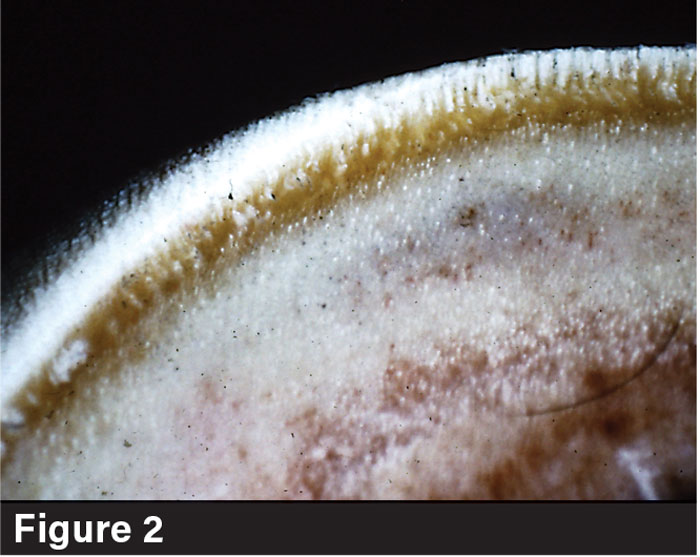
The hoof wall has been completely removed until it is barely discernible at the toe. The lamina is yellow from serum leaching into it. Note the bruising all over the sole. Randy Luikart
It’s obvious in Figure 2 that the wall has been removed until it’s barely discernible at the toe. The lamina is yellow from serum being leached into it, and notice the sole bruising. I pushed on that wall with my thumb and it moved. Can you imagine how a 1,000-pound horse is going to stand, let alone move, on that small amount of wall? The bruising on the sole is from P3 moving a little more than normal during weight bearing because the toe wall is not providing support (resistance) to the lamina pulling on it. Interestingly, both owners of these horses (Figures 1 and 2) thought they were lame from having a hoof that was too long. Unfortunately, any length is problematic in today’s internet-informed public.
Protective Length
Protective length is required to protect all internal structures, both anatomical and mechanical. These structures exist within the hoof and provide anatomical or mechanical cooperation among these components (arc supports on the dorsal wall and bars, for example), resisting failure from weight bearing.
The sole cup is another structure affording support to the bottom of the hoof and P3, like the bottom of a soda can does to the wall of the can. Weakening or removing these external and internal supporting structures costs structural integrity so it doesn’t function correctly and is contraindicated.
It’s rare to read anything that doesn’t tell you to shorten the hoof behind these external limitations. Even owners will come to expect it. Vets love to say that, and I doubt there’s a shoeing prescription that doesn’t include language to address the “breakover” strain.
Optimum Length
For every length and angle of the pastern, there’s a corresponding hoof length and angle to allow the hoof/fetlock to function in equilibrium. You’ve read that before in my ramblings. I’ll continue to express it until you recognize that different leg conformations above the hoof require different conformations of the hoof for the force application to be effectively and efficiently applied.
The optimum length of the hoof falls into three categories — dorsal wall length, horizontal length (center of the hoof to the edge of the toe) and vertical length (height). Altering them comes from allowing the hoof to grow or changing the hoof’s parameters through diligent trimming. This optimum length of foot is also dependent on the length and angle of the pastern. Establishing these parameters requires a square, marker and tape measure or ruler (Figure 3).
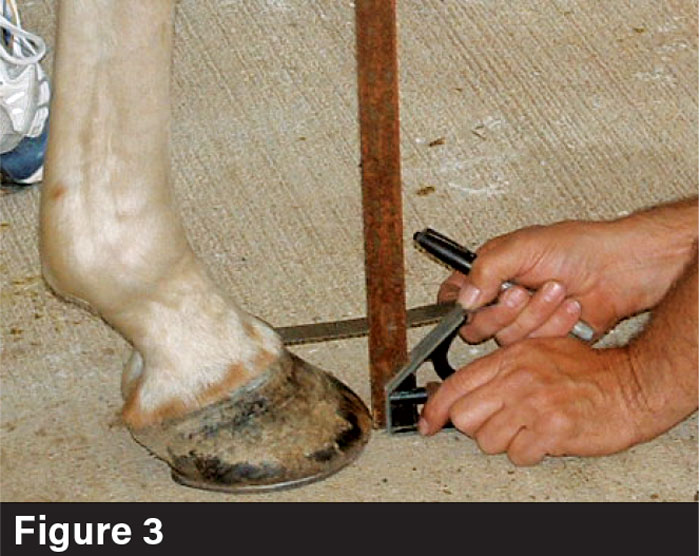
Establishing the optimum length of the foot is dependent on the length and angle of the pastern. Establishing those parameters requires a square, marker and tape measure or ruler. Randy Luikart
Use the marker to mark the hoof at the junction of the coronary band to the hoof at the toe, the front of the pastern joint at the M3/P1 junction and the side of the joint at the base of M3. The purpose of these marks is to measure and calculate the various lengths, adjust them to correlate to what length is deficient and measure the change. I use a calculation sheet to log the information in some kind of order that makes sense (Figure 4).
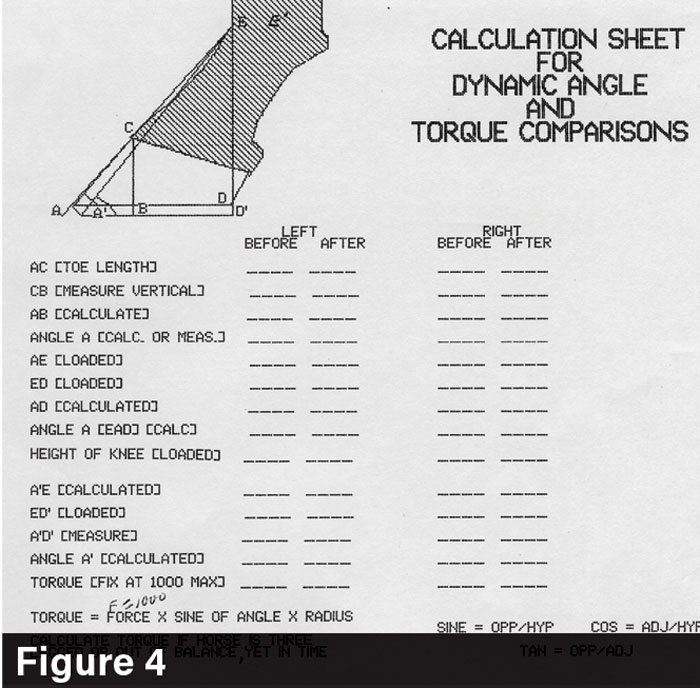
A calculation sheet logs information to ensure it is in order and makes sense. Randy Luikart
This process is based on physics and utilizes trigonometry to establish the results. Trigonometry was defined on isosceles right triangles, but these formulas are valid on any right triangle, which is what we use here. Look at the triangle formed at the toe of the hoof (ABC) in Figure 4. The dorsal toe length (AC) of a hoof at 45 degrees (isosceles right triangle). Both the vertical height (CB) and horizontal length (AB) will be the toe length multiplied by 0.707 (sine of 45 degrees). These measurements are used to evaluate the mechanics of the hoof to the contralateral hoof as a comparison. These formulas also assist you in calculating the mechanical angle of a deformed toe (bull nose or dished), rather than an incorrect angle gauge on deformed hooves.
If you look at the triangle formed by the distal limb (AED), that’s the complete triangle to evaluate the pastern/fetlock/hoof mechanics. Ideally, measure to the center of rotation. Since we can’t do that, the external markers are fine because we are measuring a change from what we started with. All measurements should be accomplished with the contralateral leg lifted to simulate a loaded limb. You are trying to make a dynamic evaluation of the limb, so doing this will put the leg in the mid-stance position of weight bearing. Mid-stance is probably the only position we can clinically evaluate statically.
Let’s do a little of that measuring. Referring to Figure 3, position your square at the toe on a flat surface, with the other leg picked up. Place your measuring device parallel to the ground and measure to point C and record the distance. Move your ruler farther up the square and measure to the mark you made on the front of the leg, point E. Record that distance. These two distances correlate to distance AB and AD, respectively, on the calculation sheet. Length BD also correlates to a parallel line from point C to line BD. Recording these measurements on two contralateral legs often exhibit mechanical variances not necessarily exhibited in the feet (yet).
As the fetlock loads, it drops so ED becomes shorter and the parallel line to BD from point C becomes longer. The angle formed by M3 and P1 extends. Distance CE is the hypotenuse and reflects the distance from the proximal end of P1 to the distal end of P2. It must be that way because the superficial digital flexor tendon attaches at the pastern joint.
To calculate the pastern angle at E, use any two measurements to fit any of the trigonometric equations contained on the calculation sheet. CE is the hypotenuse. Length AE minus length AB (loaded) is the opposite side of the angle formed. Use the sine function to find the angle in degrees (you will need a mathematical calculator).
For the sake of discussion, let’s say the angle is 45 degrees. Now take the formula Torque = Force x sine of the angle x radius (also found on the calculation sheet) and plug in the information to solve the problem. Radius is the length of the pastern (CE). You can set force at 1,000, since if you recalculate after you shoe the horse, it’s the same horse, so it weighs the same. Take the sine of the angle you solved (in this case 45 degrees; the sine is 0.707). So, the formula would read: Torque (at the fetlock) = Force (1,000 lbs.) x 0.707 x CE (let’s say that pastern is 4 inches). Doing the math, fetlock torque equals 2,828-inch pounds.
Why figure this out? When you compare the contralateral limbs, variations present themselves in the mechanical orientation of bones, lengths and angles formed during this small amount of load presented by lifting the opposite limb and measuring. Increase the pastern length to 6 inches in that formula and the torque rises to 4,242-inch pounds. Higher force application requires more ground interaction resistance in some manner to accomplish efficient propulsion. Bigger trucks and motors require bigger tires; it’s a physical fact.
Unfortunately, when gathering this information, the foot triangle ABC is the same on those two different pastern lengths in force application by today’s standards of horseshoeing. In fact, the standard non-mechanical thought process is that all the feet should be the same around the coffin bone, symmetrical, set back, squared off and as short as possible.
Gain more insight about hoof wall length by:
- Reading “There’s More to Toe Length than Meets the Eye’,” in which Hall of Famer Randy Luikart discusses the many factors to consider.
- Reading “Putting a Number on Ideal Hoof Wall Length,” in which Gerard Lavery of Surrey, British Columbia, explains how proper measurements can point farriers in the right direction.
- Reading “Maryland Farrier’s Toe Length Protocol Keeps Show Horses in Top Form,” in which Harry Serio details how a tape measure, dividers and hoof protractor help maintain proper foot parameters.
That hoof is the applicator of force to the ground so the horse can propel itself. The point where that force exceeds the hoof’s ability to stay supportive for that force application allows the horse to slip from that lack of resistance. I am sure you can appreciate that walking on ice and concrete requires you to alter the way you walk and apply force to those two substrates.
Think how the horse has to accommodate the lack of enough resistance by the hoof to apply that application force and still perform. Having that optimum length of hoof allows the horse to have confidence that it can apply all the force it wants without ground interaction failure. The optimum hoof length will be when AB/AD x 100 = less than 50%. Interpolation of that length (AB) on how the foot is growing and changing requires making notes. The optimum length should never exceed 50% on that horizontal comparison.
You cannot maintain mechanical optimum all the time. Once you establish what that length and angle is for each horse, you also have to track how the hoof grows, both in length and angle changes. This information allows you to interpolate where the hoof will be in the time period of shoeing. In other words, if the horse needs to be optimum for a world championship show 6 weeks away, then you know how to manage that growth so that optimum is reached, but not exceeded.
The optimum length and angle provide the limb with the correct mechanics, providing full range of motion of the limb joints. What would be optimum for the horse would complement its preferred gait stride and frequency that is most efficient for movement. That optimum will be different for each style of performance and distal limb conformation. It also depends greatly on the abundant knowledge that the general horse-owning public has on what length of the foot is right (generally speaking, the shorter the better) and if the owner/veterinarian will accept your argument based on mechanical fact. Nonetheless, the optimum range is what we are looking for, not merely protective, too short or too long, but just right.
Too Long Length
Too long a hoof is just that, a hoof wall that is longer than mechanically optimum.
I don’t know how we got off base and down the road that the smaller the hoof, the better (probably from easing the breakover discussions). I guess it’s easier for people to think about rather than practice the above method. I’m not the only one to think about it because the introduction to William Russell’s book, Scientific Horseshoeing, contains language that shorter pasterns require a shorter hoof and longer pasterns require longer feet to be in balance (mechanical equilibrium). I guess as a community, we have just gotten off track by following intuitive thinking and pseudo-science, rather than physical facts.
Perhaps we can have that breakover exposé next time.

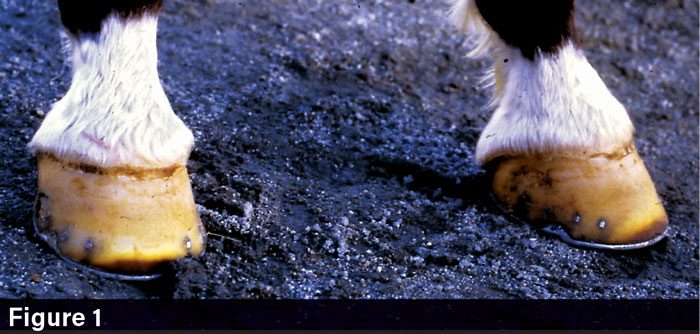

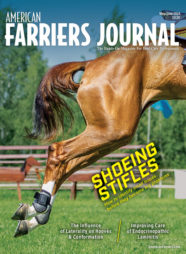

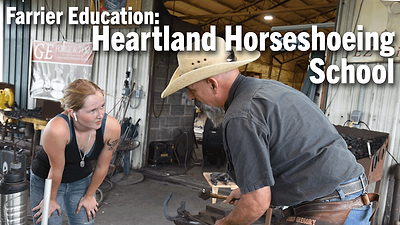



Post a comment
Report Abusive Comment